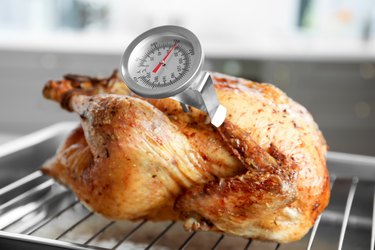
Sure, man may have survived hundreds of thousands of years without having to use a meat thermometer to test his food before serving, but if you've ever gotten sick from undercooked meat, chances are that you'd rather not have to survive that experience again. Fortunately, preventing foodborne illness from undercooked meat is actually pretty simple as long as you invest in nothing more than a simple meat thermometer.
Choosing the Right Turkey Thermometer
Video of the Day
Many turkeys now come with a pop-up thermometer already inserted. While these are better than using no thermometer, they are nowhere near as useful or accurate as a real meat thermometer.
In fact, when Consumer Reports tested the accuracy of these devices, they found that three of the 21 thermometers tested popped up before the meat reached the 165 degrees Fahrenheit necessary to kill bacteria, such as salmonella, that can result in dangerous infections.
One of the thermometers even popped up at a troubling 139.5 degrees, meaning the turkey would still have been highly unsafe to eat. Sometimes pop-up thermometers also get stuck, leaving you with dry, overcooked meat, which is also a major bummer (though still not as bad as salmonella poisoning).
So, you know you want to get a real turkey thermometer rather than a pop-up thermometer, but should you get an instant-read or a standard meat thermometer? Experts say either way is fine as long as you know how to use them properly.
Instant-read thermometers can be read easily and quickly, but they are not oven proof and need to be inserted into a turkey that has been pulled out at least partially from the oven. Standard meat thermometers should be inserted into the turkey before it is put in the oven and checked periodically as the meat cooks.
A Thermometer to Avoid
One final thing to remember when measuring turkey temperature while cooking is to avoid an infrared laser thermometer. While these cool toys are fun to use since they can measure temperatures without touching the surface, that's all they can measure — the surface. The whole point of measuring the temperature of the turkey is to know if the inside is cooked enough, which is something these thermometers absolutely cannot do.
Measuring a Turkey's Leg Temperature
While oven-safe thermometers and instant-read varieties vary in that one can be left in the oven and the other can't, the way they are inserted is the same either way. You always want to check your meat's temperature by measuring the thickest part of the meat, but because breasts cook faster than the rest of the bird, it's important to instead check your turkey's temperature in the thigh. The turkey leg temperature should be 165 degrees Fahrenheit or 74 degrees Celsius.
To measure the thigh temperature, insert the thermometer into the thickest part of the thigh near the rest of the body, under the drumstick and away from the bone. Insert the thermometer parallel to the turkey's body up to the dimple on the probe. If you hit something hard, you have hit the bone and should attempt to position the thermometer again. If there seems to suddenly be too little resistance, you've likely hit the cavity and need to reposition the thermometer.
When you are finished testing the turkey thigh temperature with a probe, be sure to wash the metal part thoroughly before storing it for the next use.
Check out this related video from ExpertVillage on Youtube
- Consumer Reports: Trust A Meat Thermometer Over A Pop-Up Timer For Your Turkey
- Fine Cooking: How Useful Is a 'Laser' Thermometer?
- University of Illinois Extension: Using a Thermometer
- Epicurious: How to Check the Temperature on a Thanksgiving Turkey
- The Kitchn: How To Check the Temperature on a Turkey